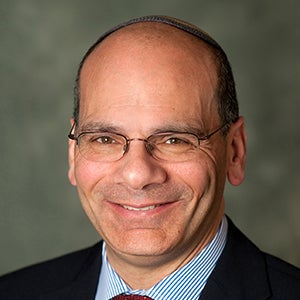August 12, 2024
The following column originally appeared in The Times of Israel.
Her enemies are now the masters, her foes are at ease…her infants have gone into captivity before the enemy.
Look about and see: Is there any agony like mine, which was dealt out to me?
Hear, all you peoples, and behold my agony: My maidens and my youths have gone into captivity!
I cried out to my friends, but they played me false.
(Selected verses from Eichah 1, New Jewish Publication Society translation)
Uncanny in their descriptive accuracy of October 7 and its aftermath, the above words could have been new elegiac poems written in the first hours, days, and months after that painful day.
Instead, they are from the first chapter of the biblical Eikhah, Lamentations, an early response to the paradigmatic Jewish tragedy, the destruction of the First Temple at the hands of the Babylonians in 586 BCE. They are the words that Jews will chant as they gather in fasting and mourning on the first Tisha B’Av (August 12-13) since October 7.
Tisha B’Av is the receptacle of Jewish mourning for all the tragedies that have befallen the Jewish people, including the destruction of the First and Second Temples. Historian Shaye J.D. Cohen described Lamentations as “the eternal lament for all Jewish catastrophes, past, present, and future.”
It is too soon to tell whether Tisha B’Av will be elastic enough to include October 7. The horrors of the Holocaust were too vast and required their own day of remembrance. And October 7’s date on the Hebrew calendar, Simchat Torah, among the most joyous of holidays, may prove difficult as an official day of mourning for the deadliest day for the Jewish people since the Holocaust.
Despite returning from my third solidarity visit to Israel since October 7, describing the emotional state of our Israeli siblings remains an elusive task. There continue to be Lamentations-like expressions of sadness. How can there not be? Some 1,200 people were killed on October 7, most of them unarmed men, women, children, and babies. The death toll for Israeli soldiers in the Gaza ground offensive is 332, with deaths still being announced quite regularly; 111 people are still held hostage in barbaric captivity under life-threatening circumstances, with a significant number among them already dead.
Even as the immoral enemy is ultimately responsible for the deaths of the innocents in its midst, we mourn, as well, the deaths of all innocents, especially the children, all created in the image of God.
Too few in the world empathize with the State of Israel and its right – no, obligation – to defend itself on the seven fronts orchestrated by Iran, and thereby protect all of us from worldwide terrorism. And we are confronting a dramatic explosion of antisemitism across the globe that has been supercharged by an illogical anti-Israelism in the wake of Israel’s harshest victimization in its history.
This is not nearly the whole story of Israel at this moment. There was heroism on October 7 and every day since. A people on the verge of civil war over judicial reform came together to help one another in every way possible, embracing the victims and their families, advocating for the hostages, and supporting the displaced and soldiers with patriotic Jewish love.
A defiant quest for normalcy amid pain – a uniquely Israeli characteristic – has filled restaurants, concerts, and other gatherings with joyful resistance. There is a surreal normalcy to the streets of Jerusalem, Tel Aviv, and beyond that belies a country at war.
Most of my most recent time in Israel was spent with 200 denominationally and geographically diverse rabbis participating in the annual 10-day Rabbinic Torah Seminar at the Shalom Hartman Institute. We navigated the Jewish literary canon for insight and meaning during this unprecedented moment in our Jewish leadership lives. We supportively embraced our Israeli family, and they did the same for us, too. We chronicled, interpreted, and memorialized but we also sang together of the miracles of the State of Israel and Jewish continuity.
On the field trip day, two large rabbinic groups visited the Gaza envelope. It was my second visit to Kfar Aza post-October 7, and this time was more challenging because we were led by a resident who is among the 20 who have returned to resettle and rebuild Kfar Aza, a commitment they find both therapeutic and consistent with their pioneering spirit.
They carry the pain of knowing all the victims personally and an intimate awareness of every location where horrors were perpetrated, and yet they persist with their reclamation. Our resident guide articulated what so many have intimated – that they are a long way from the P of PTSD, as the trauma continues unresolved.
While we were in Israel, the parents of hostage Hersh Goldberg-Polin, Rachel and Jonathan, inaugurated a “Week of Goodness,” which began with an evening of communal singing at the former Jerusalem train station. Close to a thousand Israelis and visitors joined together in singing Israeli classics. It was more like a prayer-gathering than a concert. The deeply emotional hour began with Jon Polin leading a responsive chanting of Psalm 121 and concluded with Hatikvah. We cried and swayed with old friends and new ones we just met.
These are experiences that fill us with tikvah, hope. There are a few verses of hope in Lamentations, including the penultimate verse. It is repeated at the end of the book so that we might end on a positive note, something especially needed at this unprecedented time for Israel and the Jewish people: “Hashiveinu, Adonai, eilekha v’nashuvah, chadeish yameinu k’kedem.”
“Take us back, O Lord, to Yourself, and let us come back; Renew our days as of old!”
Rabbi Noam E. Marans is AJC Director of Interreligious Affairs.



